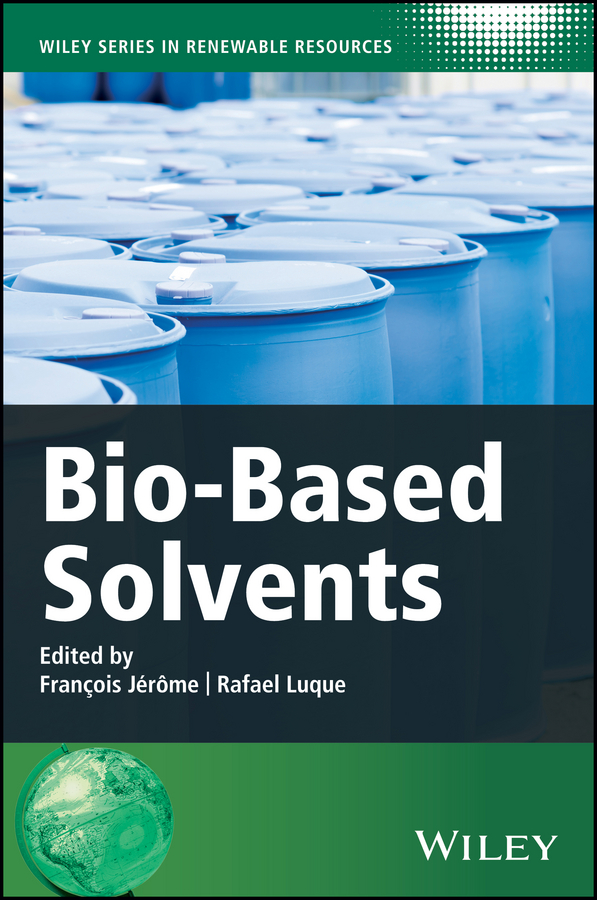Электронная книга: Rafael Luque «Bio-Based Solvents»

|
A multidisciplinary overview of bio-derived solvent applications, life cycle analysis, and strategies required for industrial commercialization This book provides the first and only comprehensive review of the state-of-the-science in bio-derived solvents. Drawing on their own pioneering work in the field, as well as an exhaustive survey of the world literature on the subject, the authors cover all the bases—from bio-derived solvent applications to life cycle analysis to strategies for industrial commercialization—for researchers and professional chemists working across a range of industries. In the increasingly critical area of sustainable chemistry, the search for new and better green solvents has become a top priority. Thanks to their renewability, biodegradability and low toxicity, as well as their potential to promote advantageous organic reactions, green solvents offer the promise of significantly reducing the pernicious effects of chemical processes on human health and the environment.Following an overview of the current solvents markets and the challenges and opportunities presented by bio-derived solvents, a series of dedicated chapters cover all significant classes of solvent arranged by origin and/or chemical structure. Throughout, real-world examples are used to help demonstrate the various advantages, drawbacks, and limitations of each class of solvent. Topics covered include: The commercial potential of various renewably sourced solvents, such as glycerol The various advantages and disadvantages of bio-derived versus petroleum-based solvents Renewably-sourced and waste-derived solvents in the design of eco-efficient processes Life cycle assessment and predictive methods for bio-based solvents Industrial and commercial viability of bio-based solvents now and in the years ahead Potential and limitations of methodologies involving bio-derived solvents New developments and emerging trends in the field and the shape of things to come Considering the vast potential for new and better products suggested by recent developments in this exciting field, Bio-Based Solvents will be a welcome resource among students and researchers in catalysis, organic synthesis, electrochemistry, and pharmaceuticals, as well as industrial chemists involved in manufacturing processes and formulation, and policy makers. Издательство: "John Wiley&Sons Limited"
ISBN: 9781119065432 электронная книга Купить за 9265.99 руб и скачать на Litres |
Другие книги автора:
| Книга | Описание | Год | Цена | Тип книги |
|---|---|---|---|---|
| Sustainable Catalysis. Energy-Efficient Reactions and Applications | Highlighting sustainable catalytic processes in synthetic organic chemistry and industry, this useful guide places special emphasis on catalytic reactions carried out at room temperature. It… — John Wiley&Sons Limited (USD), электронная книга Подробнее... | электронная книга |
См. также в других словарях:
Carbon sink — A carbon sink is reservoir of carbon that accumulates and stores carbon for an indefinite period. The main natural sinks are: # Absorption of carbon dioxide by the oceans # Photosynthesis by plants and algae The process by which carbon sinks… … Wikipedia
Soy ink — is a kind of ink made from soybeans. As opposed to traditional petroleum based ink, soy based ink:*is more environmentally friendly *is available in brighter colors *improves the life span of the printers *makes it easier to recycle paper *is… … Wikipedia
Ionic liquid — An ionic liquid is a liquid that contains essentially only ions. Some ionic liquids, such as ethylammonium nitrate are in a dynamic equilibrium where at any time more than 99.99% of the liquid is made up of ionic rather than molecular species. In … Wikipedia
Fire fighting foam — Firefighters sprayed foam on structures in the Mammoth Hot Springs complex on September 10, 1988 during the Yellowstone Fires. Fire fighting foam is a foam used for fire suppression. Its role is to cool the fire and to coat the fuel, preventing… … Wikipedia
Partition coefficient — In chemistry and the pharmaceutical sciences, a partition (P) or distribution coefficient (D) is the ratio of concentrations of a compound in the two phases of a mixture of two immiscible solvents at equilibrium.[1] The terms gas/liquid partition … Wikipedia
Polydimethylsiloxane — IUPAC name … Wikipedia
